IAMM Prayer Books

Beez Neez now Chy Whella
Big Bear and Pepe Millard
Sat 31 Dec 2016 23:27
|
Islamic Arts Museum Malaysia - Prayer
Books
  We entered the first special gallery
– a beautiful, big space, all marble and cool, a
welcome break from the days heat. Housed here is a temporary collection of the
illuminated prayer manuscripts of Dala’il al-Khayrat. We are here to learn what
we can about what we feel in many ways ignorant of and feel this is a good place
to start.
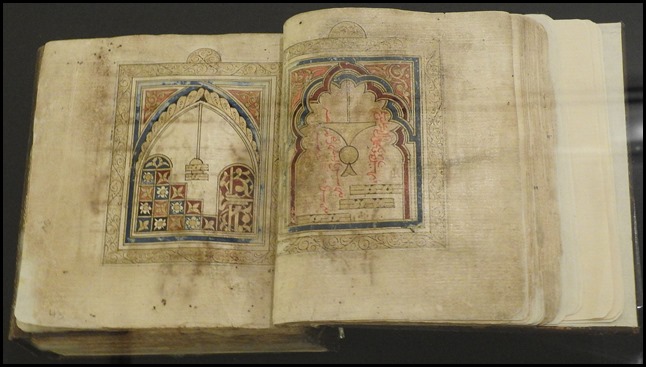 Morocco. 16th century AD / 10th
century AH. This manuscript is the oldest Dala’il al-Khayrat
copy in the IAMM collection.
Introduction:
This exhibition and its accompanying catalogue feature remarkable
illuminated prayer manuscripts of Dala’il al-Khayrat from
the collection of the Islamic Arts Museum Malaysia. Dala’il al-Khayrat reflect the spontaneous composition of salawat,
the blessings and praise upon the Prophet, composed directly from the heart of a
prominent Sufi master, Imam Al-Jazuli (died 1465). The composition has become an
important prayer book in its native land, Morocco, which has also spread across
the breadth of the Islamic lands. Today, Dala’il
al-Khayrat is celebrated as the most acclaimed source on the salawat upon the
Prophet Mohammad.
Dala’il al-Khayrat has for centuries inspired
calligraphers, illuminators and painters of court ateliers in producing
sumptuous prayer manuscripts, which reflect the distinctive designs of various
Islamic dynasties. These manuscripts uncover the story behind the text
appreciation by patrons and calligraphers, and to bring to light the skills as
well as the techniques of the craftsmen.
The tradition of reciting the
salawat of Dala’il al-Khayrat in public and private
gatherings continues until today, becoming the rationale behind this exhibition
in highlighting the significance of Dala’il
al-Khayrat and its impact on the lives of Muslims. The exhibition also seeks to
perpetuate the living practice of praising the
Prophet.
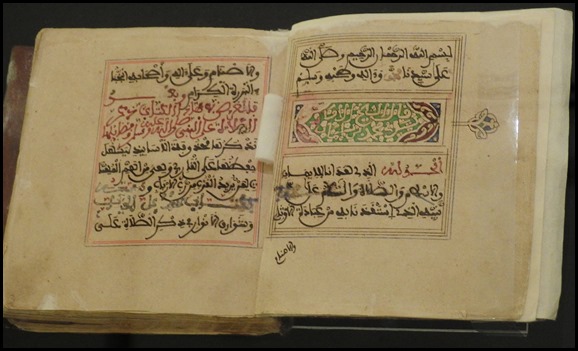 Dala’il
al-Khayrat, Morocco, 19th
century.
A Prayer Book: Dala’il al-Khayrat is a manual of salawat, blessings and
prayers to the Prophet Mohammad which was composed in Morocco during the 15th
century AD by a prominent Sufi of Shadhill school, Imam Al-Jazuli. Dala’il al-Khayrat is the most eminent and widely read prayer book
not only in its native land with the objective to assimilate the deep love
toward the Prophet Mohammad. It is considered as the most acclaimed source of
the salawat upon the Prophet Mohammad. The text were copied by many
scribes over the centuries – either produced in ateliers as a commissioned work
by a royal patronage or written down during the learning circles by disciples of
a Sufi
order.
After the time of Imam Al-Jazuli,
additional passages were also included. Some copies added Asma’ al-Husna, the
ninety nine names of Allah, and the names of twenty five prophets as mentioned
in the Qur’an. In some other copies, the instruction on the handling and
reciting the salawat is included at the beginning. The chains of
ijaza, certificate of reading or listening to the content of Dala’il al-Khayrat can also be found in several copies of this
work. As the prayer book has caught the heart of Muslims, many scholars of
Islamic thought have written an explanation or commentaries on it either
included in the margin of the copies of the Dala’il al-Khayrat or as a completely different work as a
whole.
 Surah
Al-Ahzab: 56.
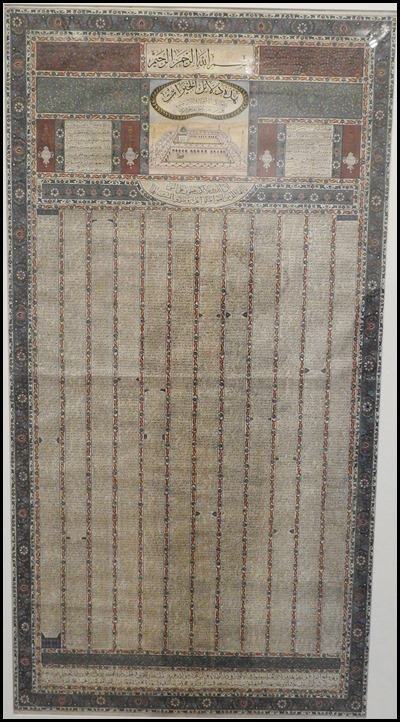 One-page Dala’il
al-Khayrat. Loharu, India. 1879.
About Imam al-Jazuli: Imam Abu
Abdullah Muhammad ibn Sulayman ibn Abu Bakr al-Jazuli al-Simlali al- Sharif
al-Hasani traced his ancestry to Imam Hassan ibn Ali, the grandson of the
Prophet Muhammad. He was a member of the Jazula Berber tribe, from a place
called Sus al-Aqsa, a town in southwest Morocco. His first nisba
(attributional name) refers to Jazula, his Berber tribe whereas his second
nisba refers to Simlala, one of the most important Berber tribes of
Jazula. He was living in Jazula where he began his quest for knowledge by
reading and memorising the Qur’an, and learning the traditional Islamic
knowledge from the scholars of his hometown.
He then travelled to Fez, and
attended lectures at Madrasah al-Saffarin where he mastered the Islamic
jurisdiction of the Maliki school and studied under the Sufi scholars of his
time such as Ahmad al-Zarruq al-Bamussi and Shaikh Abu Abdullah Muhammad ibn
Abdullah Amghar al- Saghir. From Fez, he travelled to various places including
Makkah, Madinah and Al-Quds, and stayed in these Holy lands of Muslims for
almost 40 years.
When he returned to Fez, Morocco was
facing the difficult times of political upheaval. The Portuguese was occupying
the Mediterranean and the Atlantic coasts of Morocco. It is believed that this
was the period when he composed Dala’il al-Khayrat as an assembly of prayers
upon the Prophet Muhammad. He initiated a Sufi circle of Shadhiliyyah. Those who
were close to Imam Al-Jazuli and became frequent in attending his circles of
learning amounted to 12,665 disciples.
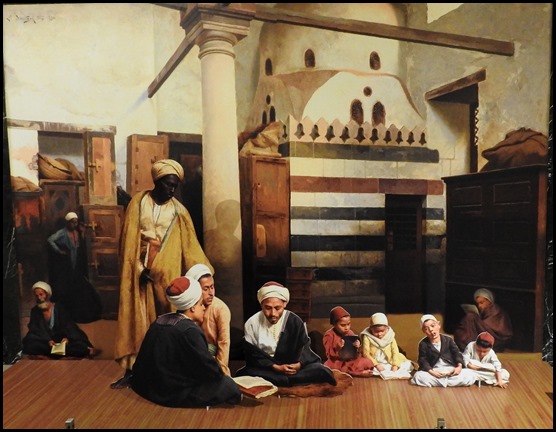 The Recital and
Ijaza: The recitation of Dala’il al-Khayrat was welcomed by Muslim
societies in the East and West. Today, these salawat upon the Prophet Muhammad
are still performed individually, besides, in public gatherings in mosques. The
recitation of the whole Dala’il al-Khayrat in one sitting may take up to two
hours, with a consistent rhythm. Such gatherings are usually conducted annually
especially during the Maulid, in remembrance the birth of the Prophet.
In the classical tradition, ijaza in
reciting the Dala’il al-Khayrat was granted by the shaykh (master) to his
disciples. During this session, the shaykh will listen to the recitation of his
disciples and make any corrections needed. The shaykh will also emphasise on the
adab, the manner of recitation. By obtaining the ijaza, it means that the person
is qualified for reading and leading his own circle of recitation. He may also
become the reference in teaching the salawat. The continuous lineage of ijaza,
that traced the chain to Imam Al-Jazuli are also included in copies of Dala’il
al-Khayrat.
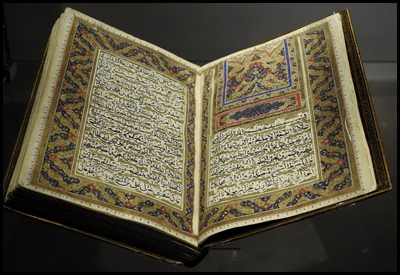  Al-Sahifa
Al-Kamila Al-Sajjadia Prayer Book. Qajar, Iran. 1851. Qasidah Al-Burdah. Mamluk probably Egypt or Yemen.
1526.
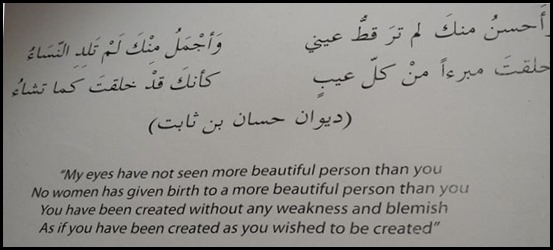 Diwan Hassan ibn
Thabit.
The
Spiritual _expression_: The love for the Prophet Muhammad has
become an inspiration to many Muslim poets around the world to compose adequate
verses of poetry expressing their love and affection to the Prophet. Hundreds of
poems dedicated to the life, message and miracles of the Prophet were composed
in different languages, some of which were translated into different other
languages and some had influenced the authorship of others.
Hassan ibn Thabit al-Ansari was among
the closest companions of the Prophet Muhammad. Besides his role as the scribe
of the Prophet, Hassan ibn Thabit was the notable poet who first composed
madih, beautiful poetry to praise the Prophet. Hassan ibn Thabit’s
poetry has spread throughout the world, and has been memorised by thousands of
people and chanted in social gatherings.
 Kitab al-Mawlid
al-Nabawi. Ottoman, Makkah. 1633.
The Chosen Prophet:
The Prophet Muhammad was born in Makkah around 570 AD. His father, Abdullah,
died before his birth and his mother, Aminah, died when he was about six years
old. He was placed under the protection of his grandfather, Abd al-Mutallib
until the age of eight. Abd al-Mutallib was an influential leader of the Arab
tribe, Quraysh. After his grandfather passed away, the Prophet was then
entrusted to his uncle, Abu Talib. As a young man, like many other Makkans, the
Prophet Muhammad became engaged in trading. At the age of twelve, he accompanied
his uncle, Abu Talib in a merchant caravan as far as Busra in
Syria.
After hearing about the unimpeachable
character of the Prophet, which gives him the title ‘Al-Amin (the Trustworthy),
Khadijah, a wealthy woman, hired him to carry out her business to Syria.
Impressed with his sincerity and honesty, Khadijah soon married him. They were
blessed with four daughters and three sons who died in infancy. At the age of
forty, the Prophet Muhammad received his first revelation. The revelation
continues for twenty three years, collectively they are the Qur’an.
In the year 610, the Prophet lost his
wife, Khadijah, and uncle, Abu Talib. Two years after that, the Prophet migrated
to Madinah, This migration marks the beginning of the Muslim era. In 632 AD, the
Prophet Muhammad returned to Makkah to perform hajj, the pilgrimage. During this
event, the final revelation came upon him. The Prophet Muhammad passed away in
the same year in Madinah. His tomb is located in the Prophet;s Mosque, in the
area called the Rawdah.
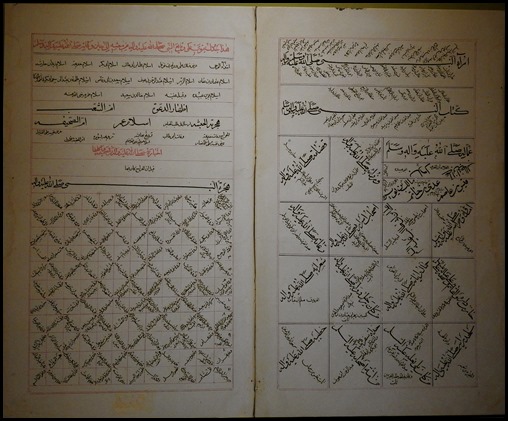 Tuhfat
al-Khaqan. Qajah, Iran. 1818 AD.
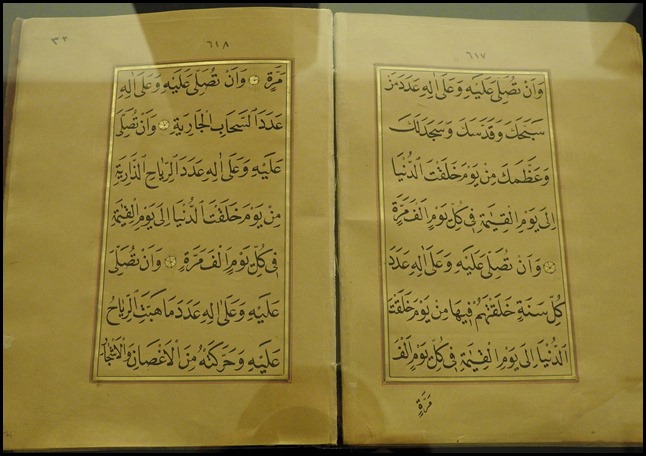 Dala’il al-Khayrat. Ottoman Egypt or Turkey. 1862. These illuminated pages
mark the beginning of the recitation on Sunday.
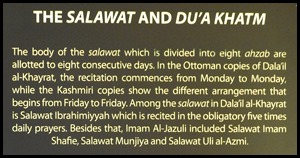 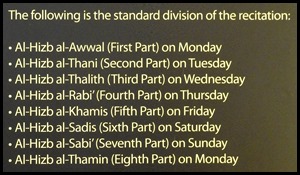  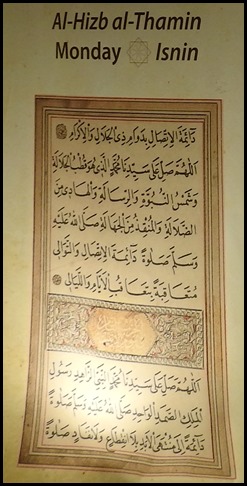 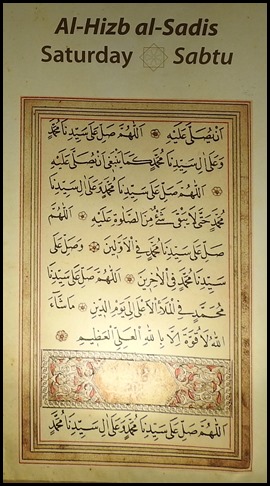 Inside Dala’il al-Khayrat: The full
title as recorded in the manuscripts is Dala’il al-Khayrat wa Shawariq al-Anwar fi Zikr al-Salat ala
al-Nabi al-Mukhtar. It can be loosely translated as ‘Guidelines to the Blessings
and the Shining of Lights, Giving the Saying of the Blessing Prayer over the
Chosen Prophet’. The text of the Dala’il al-Khayrat usually begins with the Muqaddimah, the
introduction that contains the short salawat upon the Prophet Muhammad
and his lineage, the brief explanation on the purpose and objectives of
compiling these prayers as well as the benefits and method of its
recitation.
Along with the effort of writing the
salawat, Imam Al-Jazuli has put on an initiative in compiling the 201 names of
the Prophet Muhammad from a great variety of trusted sources and composed them
in a beautiful arrangement. Another significant section in this prayer book is a
brief description of the Rawdah (the burial chamber) inside the Prophet’s Mosque
in Madinah, where the tombs of the Prophet and his two closest companions,
Caliph Abu Bakr al-Siddiq and Caliph Umar ibn al-Khattab are
located.
The compilation of Salawat
in Dala’il al-Khayrat is divided into the
days of the week, but with a special addition of one extra day. The
hikmah in dividing the prayers into eight days, instead of seven, remains a
mystery to this day. Each group of the Salawat is called hizb, and it is further
divided into halves, thirds and quarters. The phrase of the salawat
usually begins with ‘Allahumma salli ala’. Indirectly, this phrase declares
Allah as the Creator and the uncountable blessings that He showered upon
mankind.
 Beautiful to
look at even though we will never be able to read it.
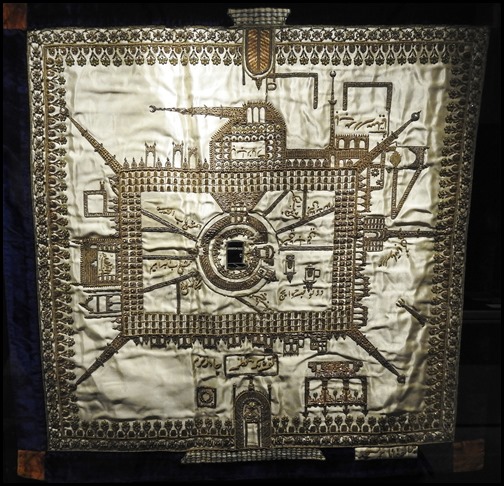 Embroidered plan
of Makkah. North India, 19th century.
 Depictions of the
Holy Mosques in Makkah and Madinah: Images of Al-Masjid al-Haram in
Makkah and Al-Masjid al-Nabawi (the Prophet’s Mosque) in Madinah, mark the final
development of the illustrations in Dala’il al-Khayrat While the rest of the illustrations were
rendered in a two-dimensional flat projection, the images of the Holy mosques in
Makkah and Madinah were executed in prospective view. This shift from a two
dimensional to a three dimensional representation of the mosques was introduced
to the manuscript starting from the second half of the 18th century AD, and
mainly from the Ottoman copies.
The Ottoman style topographical
illustration of the Holy mosques includes architectural details of the site from
a birds-eye view. The Makkah birds-eye illustration depicts different
architectural structures surrounding the Kaaba, among which Maqam
Ibrahim, the schools of the four Sunni sects, the Minbar and the
Zamzam well. Meanwhile, the illustration of the Prophet’s Mosque in
Madinah depicts the domed structure that represents the Rawdah on the
left corner of the mosque compound, the Minbar and the Garden of
Fatima. Adding to this panoramic scene are the mountains, blue skies, and other
architectural edifices.
Although the illustration of
Al-Masjid al-Haram in copies of Dala’il al-Khayrat finds no relation to the text, its presence is
due to the significant role the Kaaba plays as the sacred site for Muslims in
performing the hajj rituals. The facing images of the Holy mosques in
Makkah and Madinah continue to enhance the later lithographed printed additions
of Dala’il
al-Khayrat.
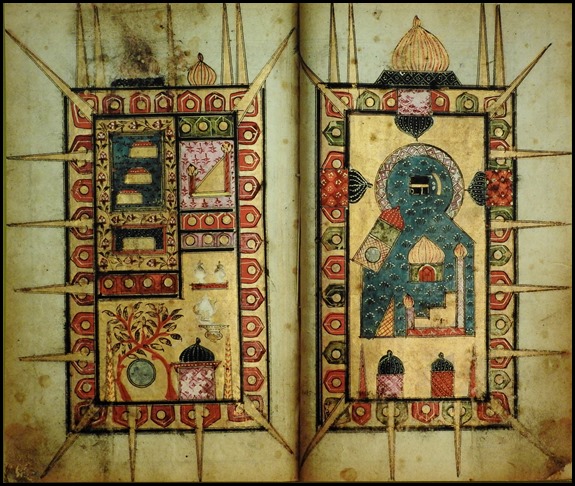 Depictions of Al-Rawdah al-Mubarakah and Kaaba:
The middle of the 18th century AD to the middle of the 19th century AD witnessed
a remarkable shift in the illustration of Dala’il al-Khayrat. A depiction of Al-Masjid al-Haram in Makkah
appeared on the right-hand side, while the images of Rawdah appeared on
the left. The addition of the Kaaba illustration into the Dala’il al-Khayrat have no relation to the text. It finds its
significance as the most sacred place to Muslims and its role as the direction
of prayer.
In copies of Dala’il al-Khayrat, the image of Makkah shows the Kaaba as its
focal point. The Kaaba is illustrated in a black square with Hajr
al-Aswad (the Black Stone) on its left corner. Adjacent to the right side
but not connected to the Kaaba wall is the crescent-shaped structure, known as
Hijr Ismail. The Kaaba is surrounded by architectural elements which
highlight the details od Al-Masjid al-Haram during the period these
illustrations were made. The four schools of Sunni Muslim; Hanafi, Maliki,
Hanbali and Shafie are usually depicted in a domed structure. Another important
element is Maqam Ibrahim, which is usually placed in front of the Kaaba
door. Furthermore, Zamzam well is featured as a domed structure with a
circle in the middle that represents the
well.
The depiction of the Rawdah
developed into different schematic drawings. The additional rectangle unit is
believed to be the depiction of the tomb of Fatimah, the beloved daughter of the
Prophet Muhammad. In various copies of Dala’il al-Khayrat, the Rawdah features additional
elements such as multiple domes and minarets and enhanced with palm trees as to
describe the Garden of Fatimah.
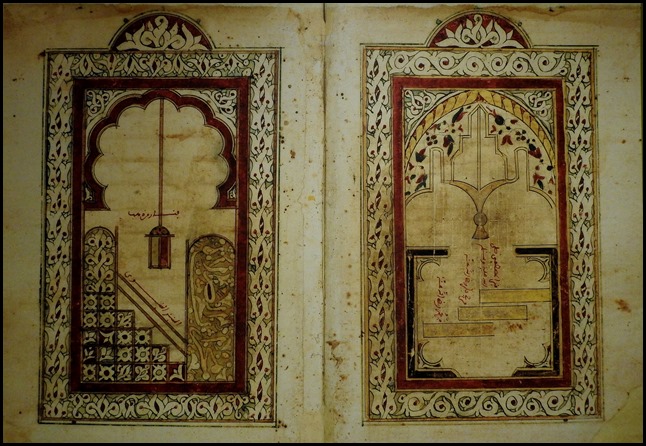 Depictions of the Rawdah and the Minbar: The
description of Al-Rawdah al-Mubarakah, the burial chamber of the Prophet
Muhammad takes up a small section in Dala’il al-Khayrat. In this section Imam Al-Jazuli says: ”This is
the description of Al-Rawdah Al-Mubarakah (the Blessed Garden) in which the
Prophet Muhammad is buried, together with his two companions Abu Bakr al-Siddiq
and Umar ibn al-Khattab.” In reference to this passage, illuminators and
painters in the subsequent centuries have been encouraged to add an illustration
of the Rawdah, which later became the focal point of Dala’il al-Khayrat. This illustration started with a schematic
drawing of the cluster of tombs, represented by three rectangles, that serves as
graphical expansion of the
text.
The second phase of the expansion of
the illustration is when the Minbar (pulpit) and the Mihrab
(qibla niche) of the Prophet were added into the manuscript, complementing the
Rawdah. Usually the Rawdah is painted on the right page of the
manuscript and the Minbar and Mihrab on the left. The tombs
remain in the form of three rectangles. The Minbar is depicted by small
squares arranged in a form of three, four or five steps. This illustration is
commonly laid under an arched niche where a mosque lamp hangs at the centre.
Keeping the two-dimensional flat projection drawing, the illustration reveals
what is significant in the North African and Middle Eastern schematic portrayal
of the Rawdah and the Minbar. In North Africa, the tradition
remains; copies of Dala’il al-Khayrat continue to depict
the illustration of the Rawdah and the Minbar until the 19th
century AD.
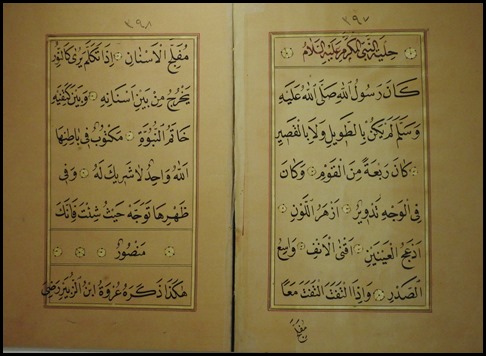 Veneration of the Prophet: The love towards the
Prophet is concerned with one’s faith. In the Shahadah, Muslims declare
the oneness of God and accept that the Prophet Muhammad is His Messenger. It is
through him that Allah sent his message of Islam to all humanity. One of the
ways to express love towards the Prophet is by knowing and understanding the
chronicles of his life account. Narratives of the Prophet’s life account can be
extracted from various religious treatises, especially the Sirah al-Nabi (Life
of the Prophet and numerous versions of Kitab al-Maulid, the book on the birth
of the Prophet. Other treatises, that speak of the Prophet’s noble genealogy and
qualities as well as indulge in emphasising the miracles that he possessed, are
placed under the genre of Dala’il al-Nubuwwah (Proofs of the Prophethood) and
Syama’il (expositions of the Prophet’s qualities and outward
beauties).
The Prophet Muhammad’s personality is
regarded as a perfect model of human conduct and behaviour. The Qur’an addressed
him as ‘uswatun hasanatun’, which means a beautiful example. For centuries,
Muslims have sought to emulate the sunnah, the way of the Prophet’s life. He was
adorned with the best qualities and good manner. He was very gentle in his
utterance. His love to others knew no bounds; he showed compassion and mercy to
his family and all people regardless of their backgrounds and belief. Equal
admiration and high esteem were shown towards him even by those who did not
believe in his message. Even before his prophethood, the people in Makkah
admired him for the truthfulness of his speech until he was given the epithet
‘Al-Amin.’ the Trustworthy.
 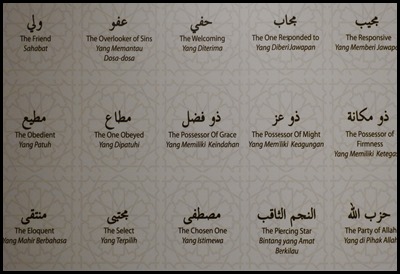 Some of the 201 names
for the Prophet Muhammad.
 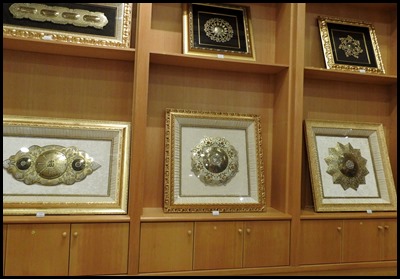 We left the gallery and crossed to the
crisp, gorgeous restaurant beyond the fountain for a
cold juice then spent a while in the shop – so many
beautiful things.
ALL IN ALL TREASURED AND HOLY
BOOKS
BEAUTIFUL CALLIGRAPHY
|